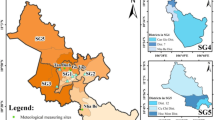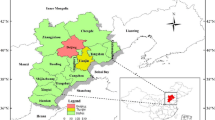Abstract
Since PM2.5 pollution has jeopardized public health, the research on how ambient fine particulate matter (PM2.5) concentrations are influenced has been increasingly important for the implementation of regional PM2.5 concentration reduction. This study analyzed the socioeconomic determinants of PM2.5 air pollution of 132 countries/economies. It was found that the main inhibitor for the PM2.5 air pollution is the emission intensity (EmI), which is measured by the PM2.5 emission when a united of energy is consumed, in every income level of countries, while the energy intensity (EnI) is the second inhibitor. Meanwhile, economic output (EO) was the largest driving factor on the PM2.5 concentrations, while population (P) growth was the second. Overall, the national employment rate (Emp) showed very little impact on the countries. This study also analyzed the income-based variation in the effects of the five factors on PM2.5 concentration changes: overall, the effects of the determinants all decreased with the rise of income levels, i.e., both the inhibiting effects of PM2.5 EmI and EnI and driving effects of EO and P performed stronger in lower-income countries than higher-income ones. Regarding the income-based variation of the determinants, this study also discussed the policy implications, such as adopting technologies on reducing PM2.5 intensity and EnI, transferring the EO from the manufacturing industry to the service industry, and international organizations on public health and environmental protection should provide targeted strategies, guidelines, and other assistances to lower-income countries as both driving and inhibiting factors performed more influential on their PM2.5 concentration changes.








Similar content being viewed by others
Data availability
The datasets used and/or analyzed during the current study are available from the corresponding author on reasonable request.
References
Ang BW, Zhang FQ, Choi KH (1998) Factorizing changes in energy and environmental indicators through decomposition. Energy 23(6):489–495
Both AF, Balakrishnan A, Joseph B, Marshall JD (2011) Spatiotemporal aspects of real-time PM2. 5: low-and middle-income neighborhoods in Bangalore India. Environ Sci Technol 45(13):5629–5636
Bu X, Xie Z, Liu J, Wei L, Wang X, Chen M, Ren H (2021) Global PM2. 5-attributable health burden from 1990 to 2017: estimates from the global burden of disease study 2017. Environ Res 197:111123
Carson RT, Jeon Y, McCubbin DR (1997) The relationship between air pollution emissions and income: US data. Environ Dev Econ 2(4):433–450
Chafe ZA, Brauer M, Klimont Z, Van Dingenen R, Mehta S, Rao S, Smith KR (2014) Household cooking with solid fuels contributes to ambient PM2. 5 air pollution and the burden of disease. Environ Health Perspect 122(12):1314–1320
Chen X, Shuai C, Zhang Y, Wu Y (2020) Decomposition of energy consumption and its decoupling with economic growth in the global agricultural industry. Environ Impact Assess Rev 81:106364
Chen X, Shuai C, Wu Y, Zhang Y (2020) Analysis on the carbon emission peaks of China’s industrial, building, transport, and agricultural sectors. Sci Total Environ 709:135768
Chen X, Shuai C, Wu Y, Zhang Y (2021) Understanding the sustainable consumption of energy resources in global industrial sector: evidences from 114 countries. Environ Impact Assess Rev 90:106609
Cheng Z, Li L, Liu J (2017) Identifying the spatial effects and driving factors of urban PM2. 5 pollution in China. Ecol Ind 82:61–75
Cox LAT Jr (2018) Socioeconomic and particulate air pollution correlates of heart disease risk. Environ Res 167:386–392
Dong K, Sun R, Dong C, Li H, Zeng X, Ni G (2018) Environmental Kuznets curve for PM2. 5 emissions in Beijing, China: what role can natural gas consumption play? Ecol Ind 93:591–601
Dong F, Yu B, Pan Y (2019) Examining the synergistic effect of CO2 emissions on PM2. 5 emissions reduction: evidence from China. J Clean Prod 223:759–771
Fisher-Vanden K, Jefferson GH, Liu H, Tao Q (2004) What is driving China’s decline in EnI? Resour Energy Econ 26(1):77–97
Fu Z, Li R (2020) The contributions of socioeconomic indicators to global PM2. 5 based on the hybrid method of spatial econometric model and geographical and temporal weighted regression. Sci Total Environ 703:135481
Guan D, Su X, Zhang Q, Peters GP, Liu Z, Lei Y, He K (2014) The socioeconomic drivers of China’s primary PM2. 5 emissions. Environ Res Lett 9(2):024010
Hervé M, Hervé MM (2020) Package ‘RVAideMemoire’. See https://www.CRANRprojectorg/package=RVAideMemoire. Accessed 02 Jan 2021
IEA (2019) International Energy Agency. Available at: https://www.iea.org/sankey/. Accessed 23 Dec 2019
IEA (2020). International Energy Agency. Available at: https://www.iea.org/sankey/. Accessed on 08/04/2020.
Ito K, Xue N, Thurston G (2004) Spatial variation of PM2. 5 chemical species and source-apportioned mass concentrations in New York City. Atmos Environ 38(31):5269–5282
Jennings V, Reid CE, Fuller CH (2021) Green infrastructure can limit but not solve air pollution injustice. Nat Commun 12(1):1–4
Jiang P, Yang J, Huang C, Liu H (2018) The contribution of socioeconomic factors to PM2. 5 pollution in urban China. Environ Pollut 233:977–985
Jin Y, Zhang X, Liu J (2018) Factors analysis of PM2. 5 emission reduction in Chinese thermal power industry based on LMDI model. In IOP Conference Series: Earth Environ Sci 121(3):032021. IOP Publishing.
Krausmann F, Gingrich S, Eisenmenger N, Erb KH, Haberl H, Fischer-Kowalski M (2009) Growth in global materials use, GDP and population during the 20th century. Ecol Econ 68(10):2696–2705
Lai W, Hu Q, Zhou Q (2021) Decomposition analysis of PM2. 5 emissions based on LMDI and Tapio decoupling model: study of Hunan and Guangdong. Environ Sci Pollut Res 28(32):43443–43458
Li J, Ding T, He W (2022) Socio-economic driving forces of PM2. 5 emission in China: a global meta-frontier-production-theoretical decomposition analysis. Environ Sci Pollut Res 29:77565–77579
Lim CH, Ryu J, Choi Y, Jeon SW, Lee WK (2020) Understanding global PM2. 5 concentrations and their drivers in recent decades (1998–2016). Environ Int 144:106011
Liu Q, Wang S, Zhang W, Li J, Dong G (2019) The effect of natural and anthropogenic factors on PM2. 5: empirical evidence from Chinese cities with different income levels. Sci Total Environ 653:157–167
Luo K, Li G, Fang C, Sun S (2018) PM2. 5 mitigation in China: socioeconomic determinants of concentrations and differential control policies. J Environ Manage 213:47–55
Martínez-Zarzoso I, Maruotti A (2011) The impact of urbanization on CO2 emissions: evidence from developing countries. Ecol Econ 70(7):1344–1353
Meng J, Yang H, Yi K, Liu J, Guan D, Liu Z, Huang T (2019) The slowdown in global air-pollutant emission growth and driving factors. One Earth 1(1):138–148
Mukherjee A, Agrawal M (2017) A global perspective of fine particulate matter pollution and its health effects. Rev Environ Contam Toxicol 244:5–51
Poumanyvong P, Kaneko S (2010) Does urbanization lead to less energy use and lower CO2 emissions? A cross-country analysis. Ecol Econ 70(2):434–444
Sadorsky P (2013) Do urbanization and industrialization affect EnI in developing countries? Energy Econ 37:52–59
Shen X, Lin B (2020) Policy incentives, R&D investment, and the EnI of China’s manufacturing sector. J Clean Prod 255:120208
Song W, Jia H, Huang J, Zhang Y (2014) A satellite-based geographically weighted regression model for regional PM2. 5 estimation over the Pearl River Delta region in China. Remote Sens Environ 154:1–7
Song C, He J, Wu L, Jin T, Chen X, Li R, Mao H (2017) Health burden attributable to ambient PM2. 5 in China. Environ Pollut 223:575–586
Voigt S, De Cian E, Schymura M, Verdolini E (2014) EnI developments in 40 major economies: structural change or technology improvement? Energy Economics 41:47–62
WHO (2005) WHO Air quality guidelines for particulate matter, ozone, nitrogen dioxide and sulfur dioxide - global update 2005. Available at: https://apps.who.int/iris/bitstream/handle/10665/69477/WHO_SDE_PHE_OEH_06.02_eng.pdf;jsessionid=E81B902BB35F7CFA666594939BF6D0DA?sequence=1. Accessed 04 Nov 2020
WHO (2022) Air pollution. Available at: https://www.who.int/health-topics/air-pollution#tab=tab_2. Accessed on 07/04/2022
World Bank (2020). World Bank Open Data. Available at: https://data.worldbank.org. Accessed on 08/03/2020.
Wu Y, Chau KW, Lu W, Shen L, Shuai C, Chen J (2018) Decoupling relationship between economic output and carbon emission in the Chinese construction industry. Environ Impact Assess Rev 71:60–69
Xie Y, Dai H, Dong H, Hanaoka T, Masui T (2016) Economic impacts from PM2. 5 pollution-related health effects in China: a provincial-level analysis. Environ Sci Technol 50(9):4836–4843
Xu Y, Liu X, Cui J, Chen D, Xu M, Pan S, Gao X (2016) Field measurements on the emission and removal of PM2. 5 from coal-fired power stations: 4. PM removal performance of wet electrostatic precipitators. Energy Fuels 30(9):7465–7473
Xu G, Ren X, Xiong K, Li L, Bi X, Wu Q (2020) Analysis of the driving factors of PM2. 5 concentration in the air: a case study of the Yangtze River Delta, China. Ecol Indic 110:105889
Xu SC, Zhou YF, Feng C, Wang Y, Li YF (2020) What factors influence PM2. 5 emissions in China? An analysis of regional differences using a combined method of data envelopment analysis and logarithmic mean Divisia index. Environ Sci Pollut Res 27(27):34234–34249
Yan D, Lei Y, Shi Y, Zhu Q, Li L, Zhang Z (2018) Evolution of the spatiotemporal pattern of PM2. 5 concentrations in China–a case study from the Beijing-Tianjin-Hebei region. Atmos Environ 183:225–233
Zhang C, Ni Z, Ni L (2015) Multifractal detrended cross-correlation analysis between PM2. 5 and meteorological factors. Physica A 438:114–123
Zhang Y, Shuai C, Bian J, Chen X, Wu Y, Shen L (2019) Socioeconomic factors of PM2. 5 concentrations in 152 Chinese cities: decomposition analysis using LMDI. J Clean Prod 218:96–107
Zhang Y, Chen X, Mao Y, Shuai C, Jiao L, Wu Y (2021) Analysis of resource allocation and PM2. 5 pollution control efficiency: evidence from 112 Chinese cities. Ecol Indic 127:107705
Zhao B, Zheng H, Wang S, Smith KR, Lu X, Aunan K, Fu X (2018) Change in household fuels dominates the decrease in PM2. 5 exposure and premature mortality in China in 2005–2015. Proc Natl Acad Sci 115(49):12401–12406
Zhao B, Yu L, Wang C, Shuai C, Zhu J, Qu S, Xu M (2021) Urban air pollution mapping using fleet vehicles as mobile monitors and machine learning. Environ Sci Technol 55(8):5579–5588
Funding
Xi Chen thanks the support provided by the National Natural Science Foundation of China (52200221). Chenyang Shuai thanks the support provided by the Fundamental Research Funds for the Central Universities (2022CDJSKJC21) and the National Natural Science Foundation of China (52200209).
Author information
Authors and Affiliations
Contributions
Xi Chen: Writing—Original draft preparation, Visualization. Chenyang Shuai: Conceptualization, Data curation, Visualization, Writing-Original draft preparation, Supervision. Jing Gao: Conceptualization. Ya Wu: Conceptualization, Supervision, Writing—Reviewing and Editing.
Corresponding author
Ethics declarations
Competing interests
The authors declare no competing interests.
Additional information
Responsible Editor: Ilhan Ozturk
Publisher's note
Springer Nature remains neutral with regard to jurisdictional claims in published maps and institutional affiliations.
Rights and permissions
Springer Nature or its licensor (e.g. a society or other partner) holds exclusive rights to this article under a publishing agreement with the author(s) or other rightsholder(s); author self-archiving of the accepted manuscript version of this article is solely governed by the terms of such publishing agreement and applicable law.
About this article
Cite this article
Chen, X., Shuai, C., Gao, J. et al. Analyzing the socioeconomic determinants of PM2.5 air pollution at the global level. Environ Sci Pollut Res 30, 27257–27269 (2023). https://doi.org/10.1007/s11356-022-24194-z
Received:
Accepted:
Published:
Issue Date:
DOI: https://doi.org/10.1007/s11356-022-24194-z




